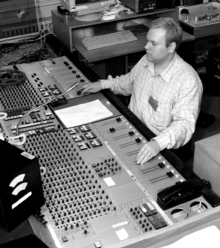Sound engineering
Sound engineering or electroacoustics is the generic term for technical devices that are used to convert, edit, record (store) and reproduce acoustic events ( sound ).
principle
Sound itself and the information and acoustic processes it contains cannot be edited or saved without technical tools. With mechanical devices, sound can only be reduced by means of sound insulation or soundproofing , as well as being deflected by means of diffusion . Electronics are used to process or even save sound information in more extensive form :
Usually, the sound is first converted with a sound transducer , e.g. B. with a microphone that serves as a sensor and converts sound waves into electrical signals. The resulting electrical sound signals, which represent the air pressure fluctuations of the sound, can be processed and / or recorded or stored and duplicated with other sound engineering devices in any number of steps . These are then output as sound waves through loudspeakers .
application areas
- Recording of music and singing (as part of music production ) or speech for e.g. As a music CD, a book, commercials, TV or radio broadcasts, cell phone - ringtones .
- Generation of electronic music (sound synthesis, MIDI ) from sound carriers such as B. the record or tapes . The usually preceding step of converting sound into electrical signals and storing them can be dispensed with if devices that generate electrical vibrations (e.g. synthesizers , samplers ) themselves produce the music or other sound information that can be output directly.
- Sound reinforcement , i.e. amplification of music and singing or speech at events, e.g. B. music events, trade fair events and conferences as well as background music in department stores and sports facilities.
- Recordings of the sound of a film while shooting , up to the production of the complete film soundtrack . The sound is processed technically independently of the image and is only brought together in the last step on a common medium so that it is perceived together with the moving image.
- Metrological recording of the volume or loudness of noises or sound events, especially noise .
- Creation of audiograms for the assessment of the individual human hearing ability as well as the hearing aid fitting.
- Hearing aid acoustics
Typical devices
Typical devices of sound engineering are microphone , A / D converter for digitizing, tone control ( equalizer ), dynamics and variable gain amplifier ( compressor , limiter , expander ), retarders ( Delay ), Hall device or space simulators ( reverberation ) and D / A converter , Amplifier and speakers .
The digital or analog mixer is used, among other things, for signal adjustment, mixing, acoustic control and mastering , and for converting into a target format such as stereo or 5.1-channel surround sound . In addition to controls for level adjustment (faders), it also contains tone controls and direction mixers (panorama controls). Additional devices such as dynamic processors can be integrated via transmission and reception paths.
Special measuring instruments such as level meters or correlation meters and stereo viewing devices are used for the technical control of the audio signal .
For decades, magnetic tapes were used to store the recordings (see also the history of video and audio systems ). With tape recorders and cassette recorders , sound was recorded in an analog manner. Analogue tapes and compact cassettes were later largely replaced by digital storage on magnetic tapes ( U-matic , DAT , DCC ), magneto-optical digital storage ( Magneto Optical Disk ), hard drives and memory cards . Due to the digital storage, the respective storage medium lost its influence on the recording quality.
Some functions of the recording studio technology can now also be realized on a standard PC. This is the most widely used tool for sound engineering today, as the so-called Digital Audio Workstations (DAWs) offer recording, playback and flexible editing options with the help of software plug-ins . Such virtual studios can realize many of the individual devices mentioned above, possibly also in combination with sound generation. DAWs can work but of course only with digitized audio signals, so you need to PC with DAW software always another A / D - and D / A converter in the form of a built-in sound card or external, often over USB or FireWire tailed audio Interface as well as microphones or other primary sound sources.
See also
literature
- Andreas Friesecke: The audio encyclopedia . 2nd Edition. De Gruyter / Saur, 2014, ISBN 978-3-11-034013-6 .
- Stefan Weinzierl (Ed.): Handbook of audio technology . Springer Verlag, Berlin 2008, ISBN 978-3-540-34300-4 .
- Dieter Stotz: Computer-aided audio and video technology. 2nd Edition. Springer Verlag, 2011, ISBN 978-3-642-23252-7 .
- Michael Dickreiter, Volker Dittel, Wolfgang Hoeg, Martin Wöhr (eds.): Manual of the recording studio technology . 2 volumes. 8th, revised and expanded edition. Walter de Gruyter, Berlin / Boston 2014, ISBN 978-3-11-028978-7 .
- Thomas Görne: Sound engineering . 4th edition. Hanser Fachbuchverlag, 2014, ISBN 978-3-446-41591-1 .
- Glen M. Ballou (Ed.): Handbook for Sound Engineers: The New Audio Cyclopedia . 5th edition. 2015, ISBN 978-0-672-21983-2 (English).
- Johannes Webers: manual of the recording studio technology . 9th edition. Franzis Verlag, 2007, ISBN 978-3-7723-5429-8 .
- Hubert Henle: The recording studio manual . Carstensen Verlag, Munich 2001, ISBN 3-910098-19-3 .
- Nadja Wallaszkovits: sound engineering. In: Oesterreichisches Musiklexikon . Online edition, Vienna 2002 ff., ISBN 3-7001-3077-5 ; Print edition: Volume 5, Verlag der Österreichischen Akademie der Wissenschaften, Vienna 2006, ISBN 3-7001-3067-8 .
